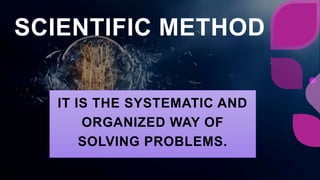
SCIENTIFIC METHODS.pptx
- 1. SCIENTIFIC METHOD IT IS THE SYSTEMATIC AND ORGANIZED WAY OF SOLVING PROBLEMS.
- 2. What are the steps in Scientific Method? Make Observations Ask a Question Results Support Hypothesis Results Do Not Support Hypothesis Draw Conclusions/Ask Questions Test Your Hypothesis Form a Hypothesis
- 3. Make Observation • Mario observed that the color of the water in the stream in their place changes to dark brown during heavy rains. He wanted to find out what causes this. He visited the place, and he noticed that few plants are present in the area.
- 4. Ask a Question or Identifying the Problem • A problem is a scientific question that can be answered by gathering evidence. In this situation, Mario identifies the problem: • Problem: What causes the water in the stream to change color
- 5. Forming a Hypothesis 1. Ask lots of “WHY” questions. 2. Look for connections between important variables. 3. Suggest possible explanations for these connections. Note: Make sue the explanations can be tested. Hypothesis - Is a tentative explanation to the problem. - It is a prediction about the outcome of the experiment.
- 6. Example: • Mario formulated the following hypotheses: • Mario’s hypotheses: 1. The loose soil causes the water to become muddy during heavy rains. . 2. If plenty plants are present in the area, then the water in the stream will not change its color.
- 7. Testing a Hypothesis 1. Think of the different kinds of data that could be used to test the hypothesis. 2. Choose the best method to collect this data: • Perform an experiment (in the lab) • Observe the natural world (in the field) • Make a model (on a computer) 3. Plan a procedure and gather data. Note: Make sure that the procedure can be repeated. Is done by experimentation, which is a systematic procedure to answer the problem.
- 8. Example : • Mario designs an experiment with variables to test his hypotheses. He decided that he could do an experiment using two pans with soil in them: one with growing grasses and the other without. The pans will be tilted, and water will be sprinkled over them. • He listed the materials he would need and wrote down the procedure to test the hypotheses.
- 9. • Materials: two pans half-filled with soil, one pan with grasses on the surface, two blocks of wood of the same size, two water sprinklers with 500 ml of water, beaker or graduated cylinder • Procedure: 1. 2. 3. 4. 5.
- 10. Collecting or Gathering Data Date are pieces of information gathered from the experiment. It can be presented and organized in charts and tables. -the data may be a written description, drawings, a list of numbers or any kind of information you observed during the experiment. Set-up Amount of water Volume of water run- off Color of run- off A. Pan with bare soil 500 ml B. Pan with soil and growing grasses 500 ml
- 11. Analyzing the Data • 1. Organizing the data as a chart such as a table, a graph, a diagram, a map or a group of pictures. • 2. Look for patterns in the chart that show connections between important variables in the hypothesis being tested. • Note: Make sure to check the data by comparing it to data from other
- 12. Data • A. Which is the manipulated variable in the experiment? • B. Which are the constant variables? • C. Which setup produces the greatest change in the change in the color of the runoff? • D. What factor affects the color and volume of the runoff? In interpreting data, the variables should be identified. The relationship of the different factors should be stated.
- 13. Making Conclusion • 1. Decide if the data clearly support or do not support the hypothesis. • 2. If the results are not clear, rethink how the hypothesis was tested and make a new plan. • 3. Record the results to share with others. Is a statement that answers the problem based on the interpretation of observation. -it is the final step of an investigation. -in making a conclusion, you will decide whether your collected data support your
- 14. Example: • Therefore, soil without plants in elevated places causes the runoff to become muddy during heavy rain.
- 15. Skills •Scientists use many skills as they work through the scientific method. Skills help them gather information and answer questions they have about the world around us. Here are some skills they use:
- 16. Observation • Use your senses to learn about an object or an event. Form a Hypothesis • Use your senses to learn about an object or an event.
- 17. Communicate • Share information with others. Classify • Place things with similar properties into groups
- 18. Use Numbers • Order, count, add, subtract, multiply or divide to explain data. Make a Model • Make something to represent an object or an event.
- 19. Use Variables • Identify things that can control or change the outcome of an experiment. Interpret Data • Use of information that has been gathered to answer questions or solve a problem.
- 20. Measure • Find the size, distance, time, volume, area, mass, weight or temperature of an object or an event. Predict • State possible results of an event or an experiment
- 21. Infer • Form an idea or an opinion from facts or observations. Experiment • Perform a test to support or disprove a hypothesis.